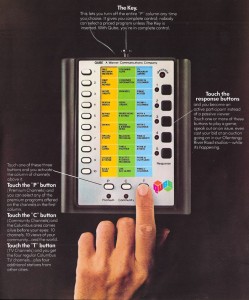Innovation is fueled by taking existing products and making them better. It’s about knowing what the customer needs before they know they need it. Companies like Apple have thrived for years by making the next iteration for products already in the market. But for a new product to be created often times, one had to pave the way. So today, we give thanks to the technology that died to make way for new:
Luke Pierce
I was eight when we got Prodigy. It was my family’s first foray, as it was many others, into the Internet. For those of you who don’t remember, Prodigy was a subscription service that offered access to things like news, shopping, weather, and games via a dial-up connection. It also added a web browsing service shortly down the road, however it was very limited. At the time, I don’t think I realized the potential of something like this. It was simply something that my dad seemed excited about as well as an excuse for me to play computer games. However looking back on it now, I realize how important Prodigy was, not just for me, but for thousands of kids my age. It served as a primer to the real Internet. Prodigy served as the foundation for the expectation I now have the ability to access information about anything I want at any given moment. With the rise of the internet browser, it didn’t take long for Prodigy to die.
Shannon Blair
When I think of a piece of technology that I am thankful to see die off I immediately think of AIM. Back in the days of middle school the most exciting part of my day was getting home from school and getting on AIM (with my dial-up internet, of course). I had my categorized Buddy List, my personalized bio and my super awesome *AwAy MeSsAgE!*. The days of LOL and BRB were created right in the world of those little 3×3 windows, and although LOL and BRB still linger I can honestly say I was glad to see AIM die off. To AIM’s credit, it did pave the way for iMessage and other forms of texting and possibly even paved the way for video chatting through Skype and Facetime. Who knows where we would’ve been without AIM, I know the social life of middle schoolers everywhere would never have been the same but honestly the creators of AIM were on the right track and did open up possibilities to advance that form of communication and technology.
If you miss those awesome 2003 away messages check out this twitter account: https://twitter.com/YourAwayMessage
Gretchen Ardizzone
Since the very beginning, there’s always been a social aspect to music, but what has changed over the years is the evolution of how it’s consumed, curated and modified like no other. Once there were vinyl records and then we had 8 tracks, and eventually, cassette tapes led the way to compact discs and mp3 recordings, but today music has moved into a world where it is collected online and enjoyed across devices. Streaming radio, while it’s been around for years is giving new shape to the way we listen. Whether it’s free or a subscription-based music service, the environment is certainly becoming competitive with Pandora, Spotify, and Rdio, all trying to fill your airwaves. Catching on to the popularity of this style of music consumption, Apple even most recently launched iTunes Radio.
What makes streaming music such a desirable platform is the capability to truly customize preferences by giving listeners the ability to identify songs they do or don’t like, share playlists, follow others to see what they’re listening to or even collaborate on making a station. Music used to be a one-way channel, but now we’re the ones modifying and making the medium what it is today. Who’s to say who will make it in the end, but I’ll be listening along the way.
Nathaniel Seevers
Back in my day, we had to walk to school. In the snow. Two miles both ways. With my brother on my back.
Ok, so none of that is true. I lived in the country. I would have never made it walking to school. I don’t even have a brother.
But I did have to use a rotary phone for a good number of years growing up, and for those of you who have never had to use a rotary phone, it’s very much like walking in the snow with someone on your back. God forbid you have to dial the area code too and chances are you’re going to screw up the last number in the set or get a phone number with a bunch of 9’s in it. You could starve to death trying to order a pizza.
Have a peek at this app if you’re feeling nostalgic > https://itunes.apple.com/us/app/rotary-dialer/id284926166
Nowadays phones are as smart as computers. Hell, we barely even use them as phones anymore. It’s all become a double-edged sword. The ability to connect so much easier, not just with a phone call but with a text, or a tweet, or a Facebook message has possibly left us less connected. But at least we can call 911 and order a pizza so much faster.
Marsh Williams
In December 1977 Warner Communications debuted the first interactive TV technology in the world in Columbus, OH: Qube. Qube was the first time people at had a direct voice in television production and programming. Today it would be called crowd-sourced TV.
Sitting at home viewers would be asked questions during a show and could respond by pressing buttons on a console about the size of a  large book. These responses were aggregated in real time and either displayed on the television as part of the programming or used by the host to guide the show. 1977, this was years before the first home computer, cell phone or the Internet, and while boring by today’s standards of ubiquitous interactive devices, it was an absolute game changer at that time.
large book. These responses were aggregated in real time and either displayed on the television as part of the programming or used by the host to guide the show. 1977, this was years before the first home computer, cell phone or the Internet, and while boring by today’s standards of ubiquitous interactive devices, it was an absolute game changer at that time.
By 1988 Qube had pretty much come and gone; however, it’s direct legacy is MTV, The Travel Channel, Nickelodeon, VH1, Pay Per View/On Demand Movies and best of all the term “Infomercial” which was coined by Carol Williams Director of Interactive Programming for Warner Communications, and my bride. All great except for one thing…
The screams in our household when programming notices come on now and promote “The first Interactive TV Experience.” It gets pretty loud and the dogs just hide under the bed.
Not a bad legacy for a small experiment.
Photo credit: Brandon Christopher Warren




